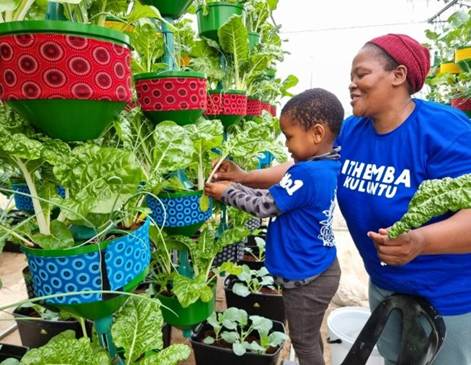From food rescue to food sovereignty: SA Harvest expands greenhouse network to build climate-resilient communities
6 min read
SA Harvest has announced a significant milestone in its long-term strategy to build a climate-resilient, community-driven food system: the completion of three greenhouses in Cape Town, Gqeberha, and rural Eastern Cape. These projects form the backbone of a replicable model for systemic sustainability — one that integrates nutrition, education, and economic inclusion into local food ecosystems.
Launched as part of SA Harvest’s mission to move beyond food rescue and tackle the root causes of hunger, the greenhouse initiative demonstrates how localised production can foster food sovereignty in structurally food-insecure communities. The greenhouses utilise Fresh Life Produce’s African Grower vertical hybrid-hydroponic growing system, which was designed to enable individuals across South Africa to cultivate their own vegetables on minimal land and thereby to foster self-sufficiency. Taking the concept a step further, each of SA Harvest’s greenhouses is strategically positioned alongside an Early Childhood Development (ECD) centre, enabling measurable nutritional outcomes, early education integration, and community ownership.
The pilot site at Tehillah Community Collaborative’s ECD in Elsie’s River, Cape Town, which was made possible through a generous grant from the Maria Marina Foundation, has flourished since inception. “This project has been characterised by abundant harvest, community engagement, and data-led impact tracking, demonstrating what’s possible when infrastructure and dignity align,” says Ozzy Nel, COO of SA Harvest. “It’s a proof of concept for how food production can be embedded in early learning and long-term development.”
The second greenhouse, completed in partnership with Missionvale Care Centre in Gqeberha, extends this model into the Eastern Cape. Missionvale has been a key beneficiary since July 2024, preparing meals and distributing food with SA Harvest. The greenhouse at Missionvale has since become a valuable case study in adaptive design, and lessons learned have shaped improvements to future builds, including enhanced climate resilience features. Commenting on how the greenhouse has impacted on the community, Missionvale Care Centre’s Linda van Oudheusden, says, “The greenhouse has had an immediate impact on 50 chronically ill patients who now receive fresh vegetables essential for taking their medication. You can’t take treatment on an empty stomach. Beyond that, we’ve trained seven unemployed youth in vertical farming — a skill they’ll carry for life — and we hope to grow the project into a sustainable income stream for the centre. In these tough economic times, it’s vital that we are part of the solution. Our enormous gratitude to SA Harvest and the SA Growers Association for this initiative, which has included specialised training for all our people. It’s an incredible journey with SA Harvest that is making a positive difference all over the country.”
“This initiative isn’t just about growing food — it’s about building systems that endure disruption,” says Nel. “What began in Cape Town is now evolving into a nationally relevant model of resilience.”
That evolution continues with SA Harvest’s third greenhouse at iThemba Kuluntu, a grassroots organisation in Pondoland led by community leaders TJ and Anke Hannemann. Through SA Harvest’s long-standing relationship with FNB, whose ECD initiatives have positively impacted over 1,200 centres and over 72,000 children, iThemba Kuluntu now hosts a fully equipped ECD centre where more than 40 women have been trained as early childhood practitioners. Additional funding from philanthropists Vinny and Charlene Lingham, through The Lingham Foundation, will enable the build of a new community centre, further embedding local development. iThemba Kuluntu will also serve as SA Harvest’s official feeding partner in the Pondoland region.
The greenhouse brought together insights from both Tehillah and Missionvale: climate-smart design, integrated nutrition support, deep local ownership, and sustainability embedded into every layer.
“What sets these greenhouses apart isn’t just the fresh produce they deliver — it’s the learning they enable,” says Ozzy Nel, COO of SA Harvest. “We’re helping young people understand the value of nutrition and where their food comes from — laying the foundation for long-term change. At iThemba Kuluntu, for example, we’ve added solar and water tanks to power the ECD centre in an area that’s extremely remote. And we’ve learnt a lot along the way; for example, rather than utilising traditional tunnel structures for the greenhouses, we designed them with a pitched steel frame to harvest rainwater and a polycarbonate roof that’s incredibly durable.”
These projects are part of SA Harvest’s broader mission to transform South Africa’s food system — from a fragmented supply chain of waste and hunger to a regenerative, circular model that works for both people and planet. By rescuing surplus food and distributing it through a tech-enabled logistics network to over 240 vetted community partners at no cost, SA Harvest is proving that food security is not a charitable act, but a systems challenge with a systems solution.
Since 2019, SA Harvest has rescued more than 24 million kilograms of food, prevented over 38 100 345 kilograms of CO₂e emissions, and delivered upwards of 94 million meals. The greenhouse initiative represents the next frontier in that mission: rooted in resilience, driven by data, and grounded in community.
For more information, visit www.saharvest.org




